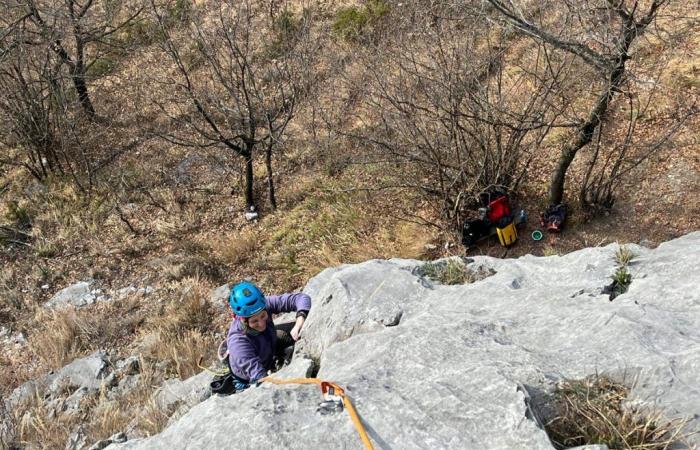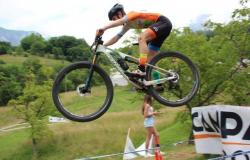When the accident is not fatal
The news
On Tuesday 4 June 2024 on the Cournalét crag (near Vernante, Valle Vermenagna, in the province of Cuneo) an approach course to climbing was held for the benefit of the first year high school students of the Giolitti-Gandino high school in Bra (CN). The course was planned as part of the Green Days project.
Along with the school group, there were some teachers from the institute as chaperones. The kids were followed step by step by two mountain guides, who explained to them the fundamentals and safety rules of this discipline.
Cournalét is in fact a cliff suitable for everyone, even beginners, with routes of varying difficulty based on your level and generously and optimally bolted. The proximity to the car parks (between 5 and 10 minutes’ walk, depending on which of the five sectors you want to reach) encourages its frequentation.
With helmet, harness and shoes, some students were tackling a low grade sector, when one of the boys, not yet fifteen years old, engaged in climbing and in any case at a reasonable height, suddenly fell, ending up on top of a professor. It is not clear whether the teacher was in the path or consciously tried to cushion the student’s fall and was overwhelmed by it.
It was around 3pm in the afternoon, the call to 112 was immediate and two helicopters arrived on site, in the presence of the health workers and the SAGF unit, the mountain rescue service of the Guardia di Finanza.
The boy, immediately intubated, was taken to the Turin CTO in very serious conditions due to head trauma. During transport he went into cardiac arrest and was successfully resuscitated. After a few days in an induced coma, he now appears to be out of danger and without having suffered any permanent damage.
The teacher suffered medium-serious injuries (yellow code), and was taken to the Cuneo hospital emergency room. He suffered trauma to his limbs and ribs.
The Cournalét Cliff
Located in the Cournalét Valley at an altitude of approximately 1200 meters and exposed to the south (sector 5) or south-west (sectors 1-2-3-4), therefore climbable all year round, snow permitting, the crag is divided into five sectors. Approximately 110 lengths of rope are traced there, with difficulty varying from 4a to 8a, between 10 and 35 meters high.
The routes are equipped with 8 mm bolts, with some exceptions with 10 mm resin bolts. Generally the bolting is close together. All belays are equipped with chains and quick links.
The cliff (also called “di Vernante”) is certainly one of the most beautiful and popular in the province of Cuneo. The surrounding environment is enchanting and under the cliff there are tables and benches for picnics, near the stream. Sector 3 and sector 5 also have multi-pitch routes (max 3), while the remaining sectors offer only single-pitch routes, for a total of about 80 bolted routes.
The rock is an excellent quality gray limestone, with great grip that gives the climber confidence. The climbing is extremely varied: there are also very technical slabs, overhangs and very beautiful and evocative vertical passages of strength and fingers. Sectors 1 and 4 have some routes with carved holds.
For details, further information and the list of routes: https://www.cuneoclimbing.it/relazioni/falesie/Cournalét.pdf
Findings and considerations
It is a widespread idea that accidents are very rare in sport climbing: unfortunately, however, we know that even the most generous bolting does not always guarantee 100% safety. Climbing remains a potentially dangerous sport, even on the best equipped and maintained crags.
Alongside the technical factor, where it is assumed that everything has been done according to the rules of the art, we must also consider the human factor, therefore the ever-possible errors, oversights and, I would add, even particular bad luck.
Investigations into the incident are underway, obviously a fault investigation is underway, but it does not seem that public opinion is particularly attentive to this incident.
When the student is “prepared” for his test, it is the instructor’s job (who in this case was a mountain guide) to check that every detail is in place, in particular the knot with which the student is tied to the rope that secures him during the climb and that will then have to support him with all his weight during the descent to the ground. It is very likely that the knot had not been completed, in fact it came undone as soon as it was stressed at the beginning of the descent. Luckily the accident was not fatal thanks to the pure coincidence of falling on another human body (that of the physical education teacher).
The episode, obviously, should make us all reflect on safety at the crag and trigger that appropriate debate which however seems not to have started.
There are many parties involved: on one side the administrations, the school and the general public, on the other the alpine guides, the FASI and Usacli technicians and anyone else who teaches or accompanies. In the past (and unfortunately also at present) we have witnessed much more often fierce arguments between the different categories of teachers than reasoned discussions centered on the interest and care for the client and/or student. Insults and complaints distance those involved from being fully aware that one day something like this could happen to any of them.
Beyond our closeness to the injured and the great regret for the guide involved in this case (who certainly will not rest for long about what happened), the negative publicity for sport climbing remains tangible, certainly “branded” for years from this serious type of unexpected event.
The fact that the accident occurred with the assistance of professionals calls into question the protocols which will certainly have to be called into question to standardize and renew them more effectively. Because now, this “safe” sport to be offered to school groups risks going backwards and being encysted in an unacceptable concept of “risk”.
The management of the guides should ask themselves questions with healthy self-criticism and therefore be at the forefront of proposing new solutions. The relationships between the different actors of teaching and accompaniment in the mountains should improve, reassuring themselves in the common vision of interest and care for those who put themselves in their hands, instead of getting lost in other legal cases, fights and poisonous discussions. Everyone should be aware that it is precisely the disputes that trigger public disaffection and the fury of justice.
Unfortunately, however, even in this case, there is a tendency to blame the law of large numbers, and therefore to archive or, worse, to try to cover it up (it is serious, for example, that this incident did not find space in the most important regional newspaper, The print).
Even though, fortunately, this accident was not fatal, it cannot be treated as a simple inconvenience, because people’s lives are still at stake.
0






